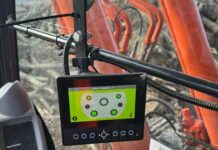HS2 has announced that 10 million tonnes of material have been delivered to – and removed from – construction sites by rail, a major milestone in HS2’s plan to cut carbon emissions by removing lorries from roads.
Businesses involved came together to celebrate at an event at Tarmac’s Tunstead Quarry, including HS2 Ltd, Network Rail, aggregate suppliers, transport solution companies, and four freight operators – along with a unique line-up of locomotives from each company.
When HS2 launched its ‘Materials by Rail’ programme in 2020, the target by 2030 was to haul 10 million tonnes of aggregate to and from sites, taking up to 1.5 million lorries off the roads using up to 15,000 freight trains.

David Speight, Delivery Director for Main Works Civils Phase One, HS2 Ltd said: “Our ‘Materials by Rail’ strategy plays a vital role in our objective to cut carbon right across the project, and we’re working hard with our joint venture companies, Network Rail, freight operators and aggregate suppliers to make deliveries by rail where possible.
“In addition to cutting carbon emissions, HS2’s ‘Materials by Rail’ strategy is creating jobs and skills opportunities right across the country, along with minimising impacts to communities along the line of route.”
Aiden Theyer, Operations Management Apprentice, Tarmac, said: “I’m so proud to have been a part of the celebration today – it’s a huge sustainability milestone, and one which has been achieved together. The overall project is a true reflection of how collaborative working with the site and industry can accomplish great things.
“If you had told me at the start of my apprenticeship that I’d be playing a part in the delivery of not only a regional but national infrastructure project of this size and impact, I’m not sure I’d have believed you! It’s a great feeling and I’m so pleased to have had the opportunity to pursue a career within construction. It really is an exciting industry to work in.”
HS2 has been working with Network Rail for a number of years to ensure that capacity on the rail network is available for HS2’s contractors to deliver their requirements by rail rather than road.
Chris Bennett-Poynter, Regional Freight Manager – North West and Central Region at Network Rail said:“We’re delighted to mark this significant milestone for HS2’s ‘Materials by Rail’ programme which is taking polluting lorries off our congested roads to transport aggregate across the country in a fast, reliable and environmentally friendly way.
“Reducing carbon emissions is a key priority for Network Rail and we will continue to work closely with HS2 and our industry partners to maximise further transportation of construction materials by rail.”
The event was attended by MP Robert Largan, HS2 Ltd’s Conventional Rail Interface Manager Andrew Graham, Managing Director – Midlands Region at Tarmac Rob Doody, Regional Freight Manager – North West and Central Region at Network Rail Chris Bennett-Poynter. Representatives from transport solutions companies also attended – Fishbone, Rail Stone Solutions (RSS), Legge infrastructure and Mendip Rail, along with the four freight operators – DB Cargo UK, DC Rail (part of the Cappagh Group of Companies), Freightliner and GB Railfreight (GBRf), and aggregate suppliers – Tarmac, Aggregate Industries, CEMEX UK and Hanson UK.
Along with freight operators and aggregate companies, UK businesses are already benefitting from contracts on HS2. There are now nearly 30,000 jobs supported by the programme and around 2,500 British-based businesses have delivered work on HS2 so far.
Once HS2 opens and moves long-distance, inter-city passenger services on to dedicated high-speed lines, the new railway will free up space for even more freight services across the country, as well as additional local and regional passenger trains.

















